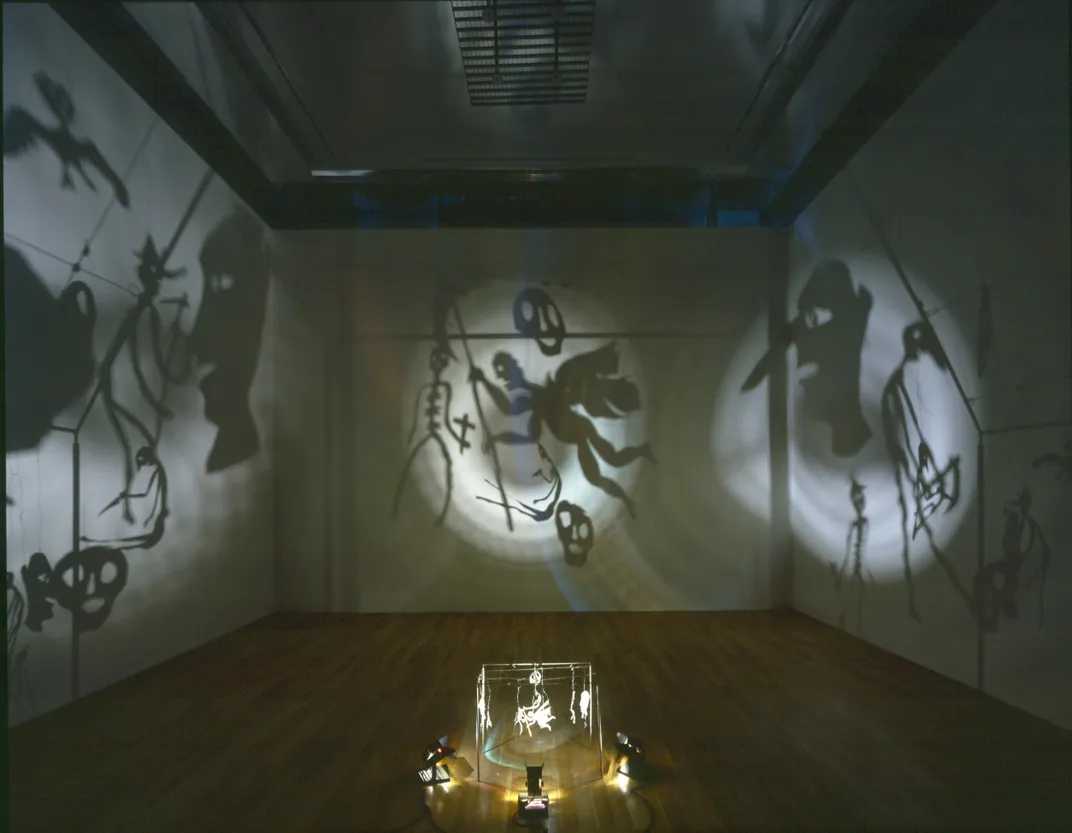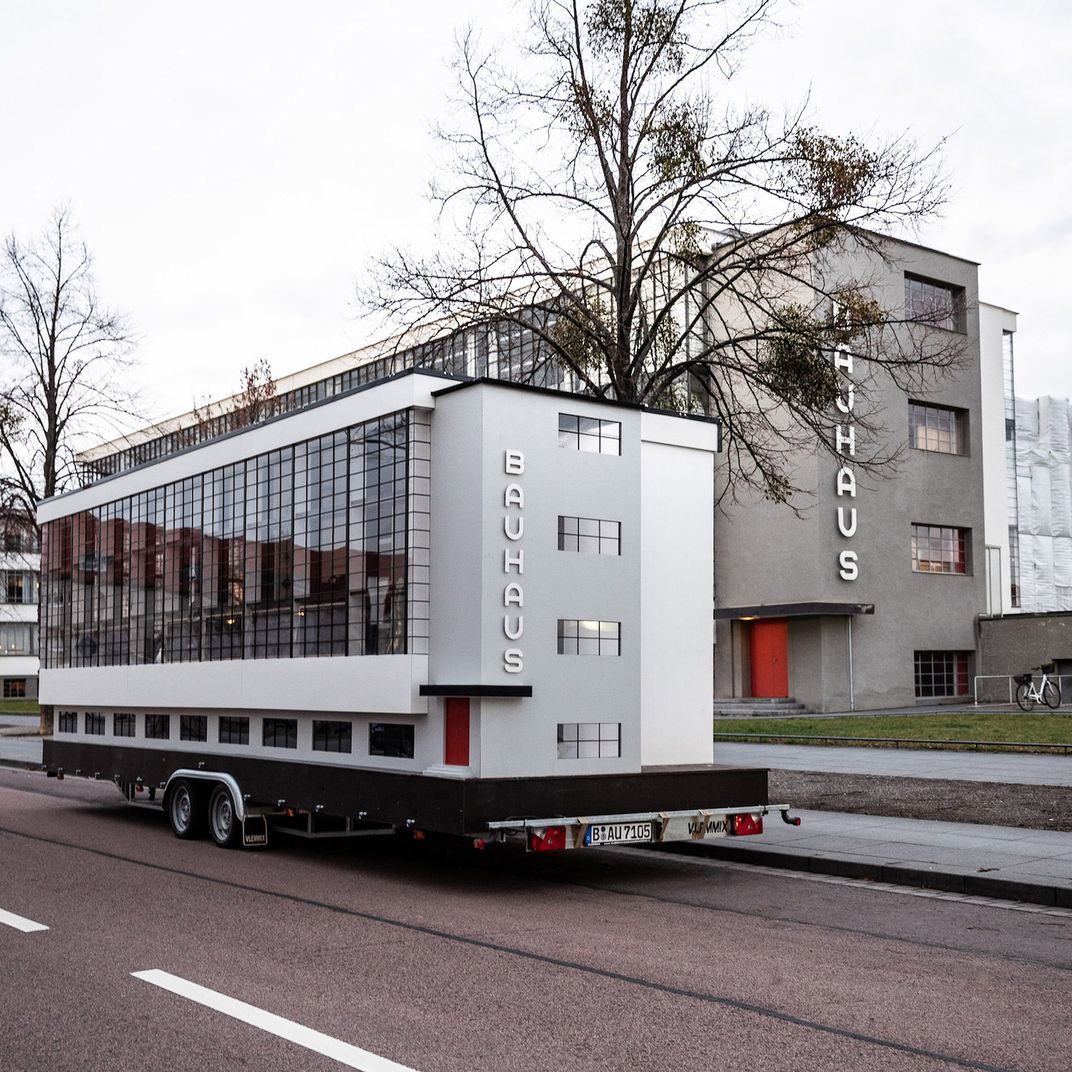Five Events to Watch For as Germany Celebrates 100 Years of the Bauhaus Movement
Bauhaus 100 looks back—and forward—to the movement that united formal art and craftsmanship in functional, streamlined designs
/https://tf-cmsv2-smithsonianmag-media.s3.amazonaws.com/filer/16/6b/166b3070-ad0b-4904-9758-8a2e61ff78c8/dessau_bauhausgebaeude_tfranzen_7380.jpg)
One hundred years ago, German architect Walter Gropius sought to unite formal art styles with craftsmanship, elevating the latter to a level of prestige previously withheld from artisans and designers.
Gropius’s declared objective was nothing short of revolutionary: His Bauhaus movement reimagined art for the modern world, with utilitarian functionality prescribing a streamlined form that still preserved the intangible spark unique to artistic expression.
Between 1919 and 1933, Bauhaus adherents across three separate German cities—Weimar, Dessau and Berlin—embraced the school’s ethos by redesigning their environments to fit its avant-garde bent. Marcel Breuer, for example, developed the so-called “Wassily Chair,” a tubular steel seat that seemingly looks more at home in a contemporary kitchen than in early 20th-century Europe, while László Moholy-Nagy pioneered the creation of sleek, easily readable sans serif typefaces.
Part philosophy, part utopian idealism and part unconventional artistic production, Bauhaus was, above all, an inspired approach toward life. Today, the school’s ideals still inform our world, from the clean lines of modern architecture to the functional design of various household items. Now, as the movement’s home country prepares to celebrate 100 years of Bauhaus with a pantheon of celebratory happenings, we’ve selected the top five events to keep an eye out for among the year of festivities:
Opening Festival (January 16-24, Akademie der Künste, Berlin, Germany)

The nine-day opening festival kicks off with around 100 contemporary artists participating in more than two dozen productions staged at Berlin’s Art Academy. Last night, artnet News’ Hili Perlson reports, jazz pianist and composer Michael Wollny began the celebrations with a musical arrangement reflecting Bauhaus’ experimental compositions. Other highlights of the festival include a dance-centric virtual reality installation exploring the relationship between man and machine, an installation juxtaposing László Moholy-Nagy’s light- and shadow-filled works with those of two modern artists, and even club nights led by musicians and DJs.
According to the Bauhaus Archive’s website, the festival builds on the legacy of Bauhaus Week 1923—an August fair featuring stage events, concerts and lectures—and the movement’s “legendary” parties. Like these earlier celebrations, the opening salvo aims to enable artists to revel in radically modern, multi- and interdisciplinary creative outlets. As a Bauhaus 100 press statement notes, the event comprises of concerts, plays, dance and film, lectures, radio programs, workshops, and even puppet theatre.
Bauhaus Imaginista: Still Undead (March 15-June 10, Haus der Kulturen der Welt, Berlin)
Bauhaus Imaginista is an extensive research and exhibition campaign designed to trace the global effects of Bauhaus theory, particularly in non-European countries. To do the massive project justice, it's been broken into four separate “chapters” hosted by institutions across the world. According to a press release, each chapter includes a host of exhibitions, workshops, conferences and discussions based on one specific Bauhaus artifact.
The project has been ongoing since the spring of 2018, but its final chapter might be its most impressive yet. From March 15 to June 10, 2019, Still Undead will take over Berlin’s Haus der Kulturen der Welt with a blockbuster exhibition of Kurt Schwerdtfeger’s “reflecting light plays,” which later formed the basis for an avant-garde cinema subculture. According to the chapter portal, Still Undead further questions the “overlapping territories of artistic expression, hedonism, micro politics, self-fashioning and commerce,” with an overall aim of interrogating how art can be appropriated for political gain.
Past chapters in the series include Corresponding With, which was anchored by an August through October 2018 exhibition at the National Museum of Modern Art Kyoto that examined the educational approach espoused by Bauhaus in relation to educational reforms in Asian countries such as Japan and India, and Moving Away—hosted first by Hangzhou’s China Design Museum and then by Moscow’s Museum of Contemporary Art—a show that explored the ways in which Bauhaus principles were adapted over the 20th century by individuals in the former U.S.S.R., India, North Korea and China. The most recent chapter, Learning From, was an initiative featuring events in Rabat, Morocco; São Paulo, Brazil; and New York City. It focused on Bauhaus members’ interest in indigenous and pre-modern material cultures, as well as the creations of North African, American and Brazilian Bauhaus practitioners.
Bauhaus and America: Experiments in Light and Movement (Through March 10, Westphalian State Museum of Art and Cultural History, Münster, Germany)
Bauhaus ideals spread far beyond Germay, reaching such luminaries as Neo-Dadaist Robert Rauschenberg, who studied under Bauhaus pioneer Josef Albers, and his stage collaborator Merce Cunningham, who later went on to influence the rise of modern dance in an international arena. Fittingly, the forward-looking exhibition Bauhaus and America: Experiments in Light and Movement follows the Bauhaus members who emigrated following the school’s closure by the Nazis in 1933 and explores how Bauhaus conceptions of light, movement and the stage are still seen in the work of such contemporary artists as Marcel Dzama, Barbara Kasten and Daria Martin. Altogether, more than 150 works representing around 50 artists are included in the show, which runs through March 10, 2019.
Not to miss: works by Moholy-Nagy and Ludwig Hirschfeld-Mack, a German-born Bauhaus artist who escaped to Britain in the mid-1930s but was deported to Australia as an “enemy alien” in 1940. Moholy-Nagy’s “Light Space Modulator,” now considered the first large-scale kinetic light sculpture, can be seen in action at 11 a.m. or 4 p.m. daily.
In February, according to host museum LWL-Museum für Kunst und Kultur, visitors can attend workshops on Hirschfeld-Mack’s “Colored Light Live” apparatus.
Bauhaus Museum Weimar (April 6), Haus am Horn (May 18) and Bauhaus Museum Dessau (September 8) openings
/https://tf-cmsv2-smithsonianmag-media.s3.amazonaws.com/filer/1d/e5/1de5e566-ebd7-4a92-8d2a-9bc1c0046260/13_presse_bauhaus100_programm.jpg)
Three new museum openings are timed to coincide with the Bauhaus 100 celebrations. First up is the Bauhaus Museum Weimar, a five-floor exhibition space scheduled to open on April 6, 2019. Designed by architect Heike Hanada, the museum is a minimalist concrete cube covered in narrow panels of opaque frosted glass. The site itself is historically significant, according to the museum’s website: To the west, an open sporting and activity space reflects the ambitious construction projects of the Weimar Republic, while directly across the street, the monumental “Gauforum” building reflects the city’s Nazi past. Boasting around 2,000 square meters of gallery space, the museum will host a collection of more than 1,000 Bauhaus artifacts, including Breuer chairs, paintings by Paul Klee and Lyonel Feininger, and a modernist teapot designed by Marianne Brandt.
Weimar’s last extant Bauhaus building, the Haus am Horn, will re-open to the public on May 18 after a series of extensive renovations that restored the house to its original appearance. Built by painter Georg Muche in 1923, the structure was designed as a model house for the movement’s 1923 Bauhaus Exhibition. According to Hickley, it was viewed as a “prototype of modern living” and featured furniture crafted by Bauhaus adherents. ArchDaily further notes that Haus am Horn was constructed using experimental building techniques and materials in hopes of cementing its status as a prototype for affordable mass-produced housing.
In Dessau, the city that housed Bauhaus following its departure from Weimar in 1925, the Bauhaus Museum Dessau will be at the forefront of this year’s festivities. Set to open on September 8, the museum was designed by Barcelona’s González Hinz Zabala, who was chosen out of 831 entrants in an international architecture competition. The building’s steel block top floor will hold the Bauhaus Dessau Foundation’s permanent collection, while its more airy lower portion will host temporary exhibitions and events. Significantly, the new space represents the first sizable home for the foundation’s collection of some 40,000 artifacts. Previously, exhibition of these artifacts has been limited by inadequate gallery space.
The Dessau museum’s opening exhibition, titled Bauhaus as Testing Ground: The Collection, will span 1,500 square meters and explore the group’s history in a series of “linked chapters.”
H/T Art Newspaper
Bauhaus Bus’ 10-Month Global Tour

A 161-square-foot bus designed to mimic Dessau’s famed Bauhaus school is scheduled to traverse the globe during a 10-month tour dedicated to exploring the movement’s influence outside of the Western world—or as Savvy Contemporary, the design collective behind the initiative, describes its purpose, “unlearn[ing]” colonial attitudes toward modernity.
For Hyperallergic, Zachary Small explains that the project, officially titled “Spinning Triangle,” is “as much a tribute to the Unesco Global Heritage Site [it mirrors] as it is a reinterpretation of the group’s legacy.” The bus is currently in Dessau, where it will remain through January 22. A stint in Berlin will follow, and from there, the bus will depart for Kinshasa, the capital of the Democratic Republic of the Congo, before concluding its journey in Hong Kong.
According to Small, the tiny traveling space was designed by Berlin-based architect Van Bo Le-Mentzel, who made the bus’ interior into a virtual clone of the Dessau Bauhaus school’s workshop wing, complete with an area for exhibitions and workshops, as well as a small library.
“Design has power,” the collective tells Gunseli Yalcinkaya for Dezeen. “It creates our environments, our interactions, our being in the world. For too long, practices and narratives from the global south have been kept at the periphery of the design discourse, been ignored altogether, or appropriated."
To combat the Bauhaus movement's Eurocentric bent, the bus will play host to workshops designed to discuss the role of everyday environments in shaping humanity’s collective future. As Yalcinkaya writes, the overall aim is nothing short of developing "an inclusive modernist manifesto.”
/https://tf-cmsv2-smithsonianmag-media.s3.amazonaws.com/accounts/headshot/mellon.png)
/https://tf-cmsv2-smithsonianmag-media.s3.amazonaws.com/accounts/headshot/mellon.png)